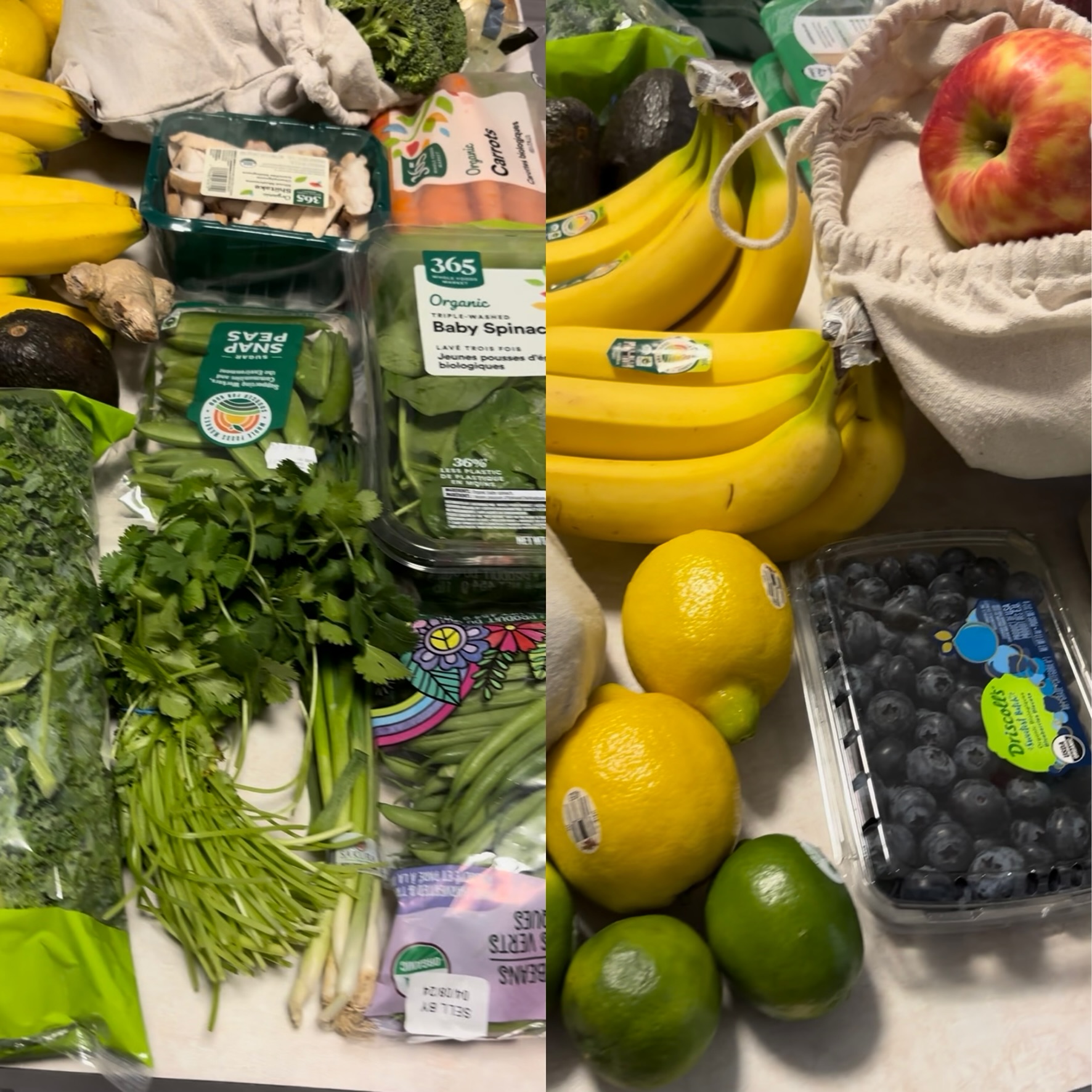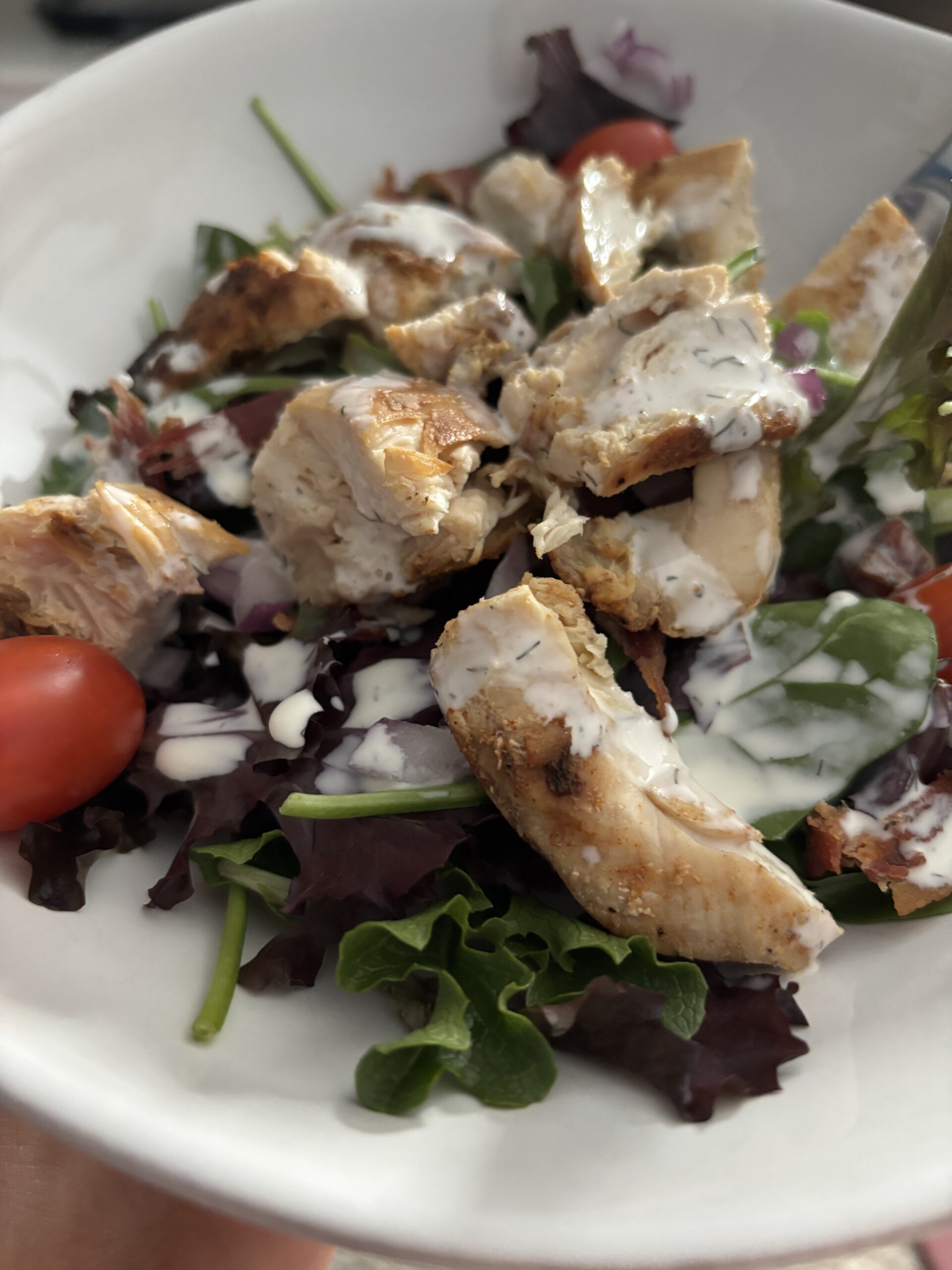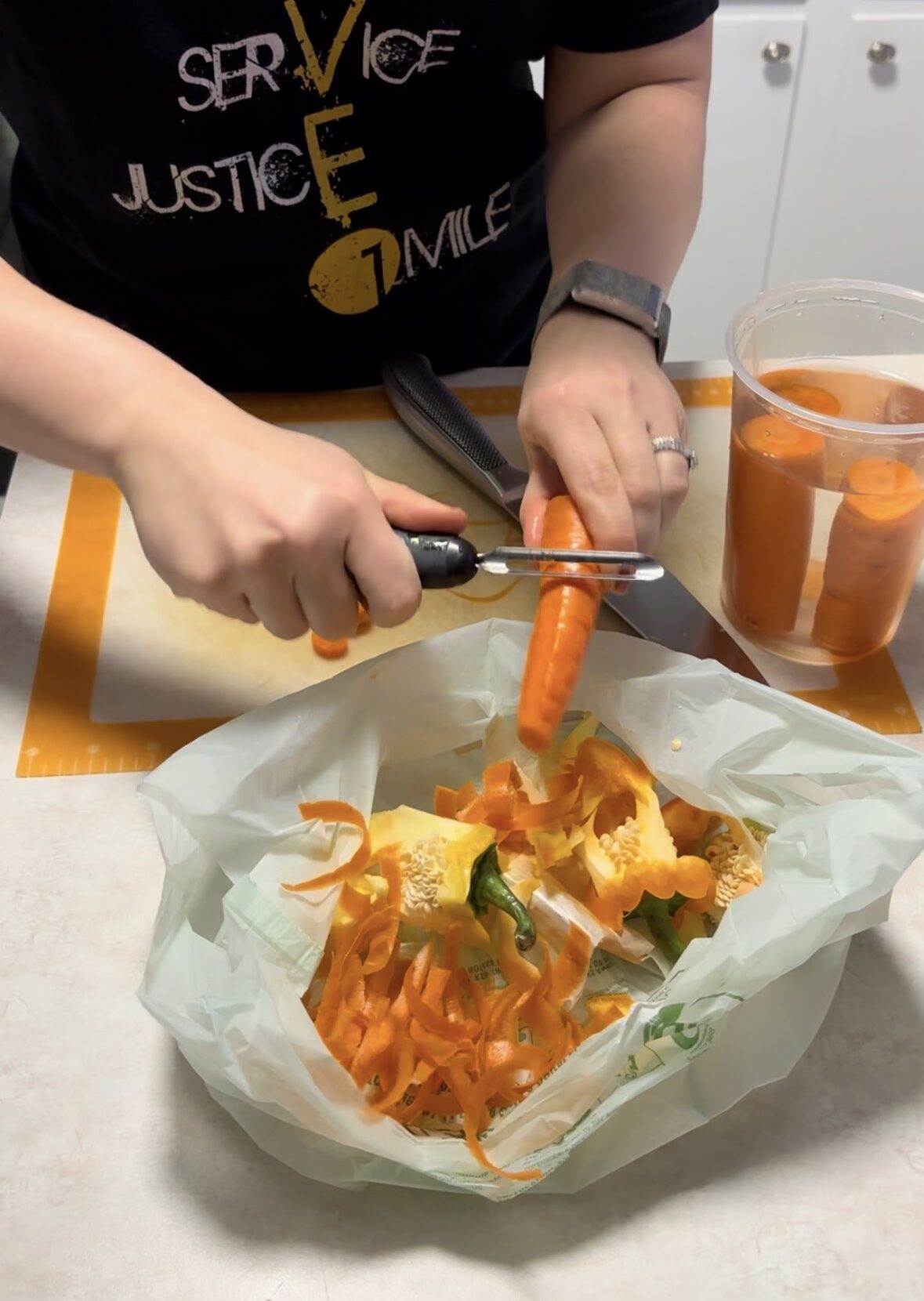Grocery Shopping = Overwhelming…
For someone who is trying to make the best choices for their health, budget, and the environment, grocery shopping can seem overwhelming. It seems like every day there’s a new Instagram video going around about a new food that you thought was good, but is now apparently bad for you, or new information on how terrible certain foods or grocery stores are for the environment. The videos are short and while you’d like to believe they are well-researched, there are a lot of contradictions. It’s difficult to try to take in that information and make logical and informed decisions.
…But it doesn’t have to be!
I still feel overwhelmed sometimes by all the information out there. However, I know that worrying about which type of fruit (or whatever is the current trend) is best for you can cause more harm than good. I love learning new things and making changes in my life based on the information I’ve learned. But I take my time and focus on slow, sustainable, and well-researched changes. This means I don’t stress over the small things. I know I’ve made broad changes (like eating more fruit instead of chips) so the type of fruit I choose probably doesn’t make much of a difference. These days I actually really like grocery shopping. It’s some non-negotiable time my husband and I get to spend together on the weekends. We’ve also gotten to know a lot of our local Whole Foods cashiers. My husband and I are both ultra-planners, so maybe the satisfaction of making a basic grocery checklist and crossing items off each week has something to do with our grocery shopping enjoyment. In sharing these grocery shopping tips, I want to make the disclaimer that we don’t follow all of these practices 100% of the time! My hope in sharing these well-researched and practical tips is to help you identify where you might want to make some improvements. I hope this helps you grocery shop stress-free while still knowing you’re making health- and environmentally-conscious decisions.
Tip #1: The most environmentally friendly grocery bag is whatever grocery bag you already have.
Most people think the obvious environmentally-friendly change you can make when grocery shopping is to choose reusable bags, right? Actually, not necessarily. Bear with me as we dig into the research a bit.
There are three main categories of grocery bags that one can generally choose from: plastic, paper, or reusable. There’s a huge push by environmentalists to avoid plastic bags altogether and to replace them with paper or reusable options. However, when looking into a Life Cycle Analysis (LCA) of the three bag options it actually shows that plastic bags (usually made of high-density polyethylene, referred to as HDPE) have the lowest environmental impact of the three. An LCA evaluates the energy use and environmental impact of a specific product over the full course of its life. This includes production of raw materials through disposal. However, an LCA does not incorporate the impact after disposal like litter or microplastic pollution. A bleached paper bag would have to be reused approximately 43 times (once a week for almost a whole year) and a cotton reusable bag would have to be reused approximately 7,100 times (once a week for almost 137 years) to equal the impact of one single-use HDPE plastic bag. Granted, a paper bag and cotton reusable bag can likely hold more than a plastic bag. Even if we assume the paper and cotton bags hold 4 times as much as a single plastic bag, they would still have to be reused once a week for 11 weeks and 34 years respectively. Each type of bag requires different raw materials, processing steps, and incurs different transportation costs and emissions due to bag weight, all of which factor into the LCA numbers and the bag’s environmental impact. The impact post-disposal of these different types of bags, not usually included in an LCA, also have a significant impact. Plastic bags are not biodegradable. Over time they do break down into smaller pieces, also known as microplastics, which pollute the soil and waterways. Plastic bags can be recycled, but typically cannot be included in municipal recycling bins. If you want to recycle plastic bags, it’s important to drop them off at an approved recycling center. Paper bags can usually be recycled through typical municipal channels, but can also be composted. Recycling in general is very energy intensive, so it’s best to use this as the last resort. Try to reuse your bags as many times as possible before you recycle! Cotton bags are biodegradable since they are derived from natural materials. However, reusable bags can also be made of vinyl plastic which is not biodegradable and can contribute to the microplastic problem, similar to single use HDPE plastic bags.
So how do we decide what bags to use with all of this conflicting information? The single rule that I follow is to save and reuse the bags you already have as many times as possible! Many people probably have reusable bags already. If you already have reusables, this is your best option. The environmental impact to produce these bags is already a sunk cost. Make the best use of them while they are in your possession. If you forget your reusable bags at home, don’t panic. There are clearly pros and cons to each type of bag you can use while grocery shopping, so choose paper or plastic and be responsible about what you do with the bag after you’ve used it. Can you reuse the bags to transport other items? What if you bring those bags back to the grocery store for another round next week? Or can you use the bags to line your trash cans instead of a fresh trash bag? Maybe you can use the paper bags to collect compost? If you’re not going to reuse the bags, can you identify a place to drop off and recycle the bags? The worst option in my opinion is buying a NEW reusable bag every time you’re at the grocery store to avoid single use paper or plastic.

Tip #2: Choose foods with less packaging.
This may also be seen as an “obvious” environmental choice. Many times it can be hard to find food without packaging or with limited packaging. The first thing you can do if you want to improve in this area is complete an audit of the foods in your grocery cart or of the food-related materials that end up in your trash can at home. Depending on what you find, here are some tips for how to make choices that end up using less packaging.
- Produce bags: Just because the produce bags are there doesn’t mean you have to use them! What can you put in your cart without a bag? You’re likely going to wash the produce when you get home regardless. Peppers, cucumbers, ginger, onions, apples, etc. are all easy to place directly in the cart without a bag. There are reusable produce bag options as well, but I would have the same concerns over reusable produce bags as reusable shopping bags from an environmental standpoint. If you already have them like we do – great, use them! If you don’t already have them it’s probably more of an impact on the environment to produce the reusable produce bags than it is to occasionally use a plastic one when you absolutely need it. If you are really cutting down on waste, try to share a package of reusable produce bags with friends. Chances are you’ll only need a few at the store at one time. Rather than everyone buying a whole package it would be better to split them up.
- Pre-cut and/or pre-packaged produce: I know it’s annoying to buy the whole fruit or vegetable and make your own fruit salad or veggie tray, but there’s a lot of packaging waste associated with the premade options. And, it usually tastes better when it’s cut and prepared fresh! If you can’t eat a whole watermelon before it goes bad, consider splitting it with a friend or neighbor.
- Plastic meat packaging: Pre-packaged meat in the store will pretty much always come in plastic packaging. However, if you go up to the meat counter to ask for something specific, they may be able to wrap it in paper. One of our local grocery stores does this. You can also consider looking for a local butcher shop or farm to purchase meat from to reduce the amount of packaging. Choosing the packages with the most meat in them will make your food last longer for less packaging.
- Protein bars or other snacks: Individual snacks are some of the most convenient options when you’re trying to eat healthy and get your protein in without taking a bunch of time out of your day. The individual wrappers really add up over time, though. GoMacro bar wrappers can be recycled for free through the company’s partnership with TerraCycle. Another option is purchasing a bag through TerraCycle to send in your wrappers from other brands. However, the best option is to reduce or eliminate this type of waste altogether. Many protein bars and other snacks are heavily processed and contain unnecessary ingredients. What if you made energy balls or protein bars at home? What if you ate more whole foods or more at meals to reduce the need to have additional snacks? There’s not one solution that will work for everyone, but try to challenge yourself with something new or different.
- Beverage containers: Glass and aluminum are infinitely recyclable, so try to choose beverages in these options and make sure you recycle them afterwards!
- Pre-made foods (mayo, BBQ sauce, marinara sauce, etc.): Again, glass and aluminum are infinitely recyclable so try to choose brands that package in these materials. You can also try making your own – we have started making our own Italian salad dressing which is super easy. You can also make your own BBQ sauce, mayonnaise, etc. If you want to make these changes, start with one at a time so it’s not too overwhelming. You can also repurpose the jars you have for other things. We use old BBQ sauce containers for our homemade salad dressings.
- Buy in bulk: You may not be able to purchase a ton of items in bulk, but see if you can find a bulk store near you. We often purchase nuts, seeds, coffee, tea, grains, and spices in bulk to reduce the amount of packaging we use. The store we buy bulk foods at requires the use of their own bags as they don’t have the capability to add new tare weights during checkout, so we save the paper and plastic bags to bring back with us to refill. Once they’ve had enough uses, we will recycle them and grab a new bag next time.
Tip #3: Eat local, seasonal and organic (if practical and within budget).
Choosing foods that are local, seasonal, and organic can all help the environment, and your health, in different ways. When you choose foods that are grown locally, you know you’re also choosing foods that are in season. Look for a farmer’s market near you to help you shop locally! This will typically help reduce the packaging of food, but will also significantly reduce the transportation costs to get food produced around the world to your local grocery store. Even if you’re buying food primarily from the grocery store, if you are able to focus on things that are in season, that likely means the distance the food had to travel to get to the grocery store is significantly less.
Many farmer’s markets also offer animal products. You can also identify a local farm where you can purchase meat in bulk (like a quarter of a cow, a full chicken, etc.). This will usually reduce the cost that you pay, will support local farmers, will decrease transportation costs/emissions, and you can ensure you get the quality of meat you want. Pasture-raised chicken, pork and eggs as well as grass-fed and finished beef are going to be the highest quality options you can choose. A few resources to help you find these in your area are www.eatwild.com and www.localharvest.org.
Lastly, organic produce can be another way to make a more positive impact on your health and the environment. Contrary to popular belief, organic farmers can use pesticides. However, only nonsynthetic (natural) pesticides are permitted and the list of permitted pesticides is significantly shorter than conventional farming. The USDA tests pesticide residue on conventional produce each year. From those results, the Environmental Working Group (EWG) publishes a “Dirty Dozen” and “Clean Fifteen” list. These lists tell consumers which produce items have the highest number (not concentration) of pesticides (Dirty Dozen) and which produce items have the lowest number of pesticides (Clean Fifteen). When reviewing the USDA data specifically for the “Dirty Dozen” foods, almost every sample tested each year is far below the EPA’s tolerance level for that pesticide. Does this mean the EPA’s tolerance level is correct or what’s optimal for us? Not necessarily. The data is also not taking into consideration the cumulative pesticides we may consume in a day if we’re eating a variety of produce. From a scientific standpoint, you could say the jury is still out on how important purchasing organic foods is. From personal experience, switching to primarily organic produce (along with other changes at the same time so I can’t confidently say this is all from buying organic foods) helped ease my periods, have more regulated moods, have more energy, and improve other aspects of my health. Buying all organic foods can be very costly, though. Even though we primarily choose organic foods, that may not be the best choice for everyone. At the end of the day, I would always choose more conventional produce and whole foods over an organic snack bar or packaged food.
Tip #4: Shop the outer edges of the grocery store.
One of the best places to start if you’re trying to eat healthier is to choose whole foods. The definition of a whole food is “food that has been processed or refined as little as possible and is free from additives or other artificial substances”. Many people will tell you to avoid processed foods. In in reality almost all foods available in the grocery store are processed in some way. For example, broccoli crowns are cut from the stems, strawberries are frozen, and a chicken is turned into chicken breasts. To help choose whole foods, try to primarily shop on the outer edges of the store. This is where you’ll typically find produce, meat, dairy, and nuts/seeds. Foods in the middle section of the grocery store are typically your pre-packaged or pre-made foods available in bottles, cans, boxes, etc. These foods can sometimes contain unnecessary or unhealthy ingredients to make the food cheaper and to make the food last longer. Some of these ingredients can cause problems due to the way the body uses them and/or how they affect bodily functions and processes. Sometimes having a list of ingredients to avoid can be helpful, but sometimes it can be super overwhelming. If it’s something that’s overwhelming to you, rather than focusing on better versions of packaged or prepared options, try to focus on buying more items that are fresh like chicken, salmon, ground beef, peppers, broccoli, apples, etc. and work to build your own meals. Buying frozen vegetables and fruits is a great way to experiment with more whole foods. They are just as healthy and you don’t have to worry about food waste if you don’t eat them in time.


Tip #5: Make a simple grocery list and a meal prep plan.
If you go into the grocery store without a plan, you’re likely to spend more money and waste more food. I call my husband and I “ultra-planners” because I know our methods are not for everyone. We usually sit down on Fridays, look at the week ahead, and pick some meals from our list of favorites. We are busy, so we usually end up preparing a large portion of about four meals for the week. If our week is looking extra busy, we’ll try to focus on crockpot meals. If we have extra time on our hands we might try a new recipe. Once we choose our meals, I’ll make a list of groceries after checking what we already have at the house, and we’ll go to the store sometime on Saturday to purchase what we need for the week. It doesn’t take a significant amount of time to have that conversation and plan out our week. It’s worth it to pre-plan our meals because it keeps us on track with our health and fitness goals. It also helps us waste less food and even save money by avoiding purchasing things we don’t need.
If you need some healthy dinner ideas to kickstart your healthy grocery list, here’s a few examples of well-balanced meals that are always in our rotation. It’s important to make sure they’re balanced with a protein, fat, and carbohydrate (the three essential macronutrients) to keep you feeling full and satisfied with enough energy for your day.
- Crockpot BBQ Chicken (protein), Roasted Fingerling Potatoes with Olive Oil (carbohydrate + fat), Steamed Broccoli + Carrots (carbohydrate)
- Scrambled Eggs (protein), Avocado (fat), Apple (carbohydrate)
- Taco-seasoned Ground Beef (protein + fat), Wild Rice (carbohydrate), Veggies like lettuce, tomato, olives, avocado, etc. (carbohydrate + fat)
- Marinated Baked Chicken (protein + fat), Roasted Sweet Potatoes (carbohydrate), Roasted Asparagus and Green Beans (carbohydrate)
- Beef Burgers (protein + fat), Quinoa (carbohydrate), Salad with Homemade Olive Oil-Based Dressing (carbohydrate + fat)
Tip #6: Let organizations help you make the best choice.
If you do need or want to purchase packaged or prepared options because that’s the best fit for your lifestyle, there are organizations out there making it easier to make better choices. It can sometimes be helpful to look for the Whole30 stamp of approval, because if something is “Whole30 Approved”, that means it’s dairy-free, grain-free, and added sugar-free. It often means there are less additives in the foods as well. In my opinion this is the quickest way to make better choices if you’re buying pre-packaged foods.
Depending on what you’re purchasing, it can also be helpful to look for certifications to help you purchase the most responsibly sourced or farmed version.
- For meat, dairy and egg products the absolute best certifications are the following:
- Certified Animal Welfare Approved (by non-profit A Greener World (AGW))
- Certified Grassfed (beef only – by AGW)
- Certified Humane
- Global Animal Partnership (steps 4, 5, 5+)
- If you want to dig into more of what these certifications mean and why they are important, here’s a great resource.
- For seafood products you’ll want to look for the following certifications:
- For farmed fish, look for the Global Aquaculture Alliance seal for their Best Aquaculture Practices (BAP) program. 4 stars is the maximum rating and is the best choice. You can also look for the Aquaculture Stewardship Council (ASA) certification.
- For wild caught fish, the Marine Stewardship Council (MSC) is the best certification out there.
- For olive oil, you’ll want to look for the following certifications to make sure you’re buying high-quality olive oil and not a blend of other oils being marketed as olive oil:
- Californian Olive Oil Council (COOC) is the strictest and is for olive oil produced in California only. The International Olive Council (IOC) is the authority for setting purity and quality standards and the COOC tests against these.
- North American Olive Oil Association (NAOOA) is another good option. They also test olive oil samples at random against the IOC standards of brands that have opted in to this certification and testing protocol. This way you’ll be confident in getting good quality olive oil, just not necessarily from California.
- For fruit (particularly bananas), coffee, tea, and chocolate you’ll want to look for the “Fair Trade Certified” certification. This certification ensures what you’re purchasing was produced in an environmentally friendly way and that people are paid fairly for their work and not discriminated against.
There are also a few companies that can help you make better choices for lower cost! Some of these options you can look into are:
- Misfits Market. This company has a large selection of organic produce and you get to choose the items that get delivered to your home at a specific frequency. Misfits Market focuses on minimizing food waste, one of the biggest problems in the US. We personally don’t use Misfits Market and based on some googling, it looks like they have some mixed reviews. But if the concept is appealing to you and it would help your grocery bill or healthy eating goals, then consider checking them out.
- Thrive Market. This company primarily has pantry and home staples. They carry a lot of the brands that health stores carry at a similar or lower cost. They also deliver to your door. Thrive Market does have an annual membership cost, but if you don’t save the amount of your membership within the year, they will refund you the rest. We also don’t have Thrive Market, but this may be a good option for people who don’t live in close proximity to a Whole Foods or other health food store. Since Thrive Market is primarily pantry and home products, there is significant packaging involved. It may be difficult to justify if you’re trying to reduce waste. This is one of the reasons we don’t have Thrive Market. We try not to purchase many packaged and pre-made foods. When we do purchase them, we get them at our local Whole Foods a few minutes down the road.
Slow changes are sustainable changes.
I know from experience that it can be difficult to change multiple things at the same time. When I was looking to make healthier and more environmentally conscious choices, I started by making only one change per month because that’s what felt sustainable for me. If it’s one change per year, that’s okay too! I hope you were able to find some evidence-based practical tips for your next trip to the grocery store so you can make the best choices for you and your family in your current lifestyle. You can always come back to this post to gather more ideas at a pace that feels sustainable for you. I’d love to know in the comments what questions you have about healthy grocery shopping or what you’ve implemented to make your trips to the grocery store more fun, healthy and environmentally-conscious.
SOURCES:
- https://news.climate.columbia.edu/2020/04/30/plastic-paper-cotton-bags/
- https://olivewellnessinstitute.org/extra-virgin-olive-oil/certifications/
- https://cooc.com/about-the-seal/
- https://www.aboutoliveoil.org/certified-olive-oil-list
- https://www.fairtradeamerica.org/the-standards/
- https://edis.ifas.ufl.edu/publication/FA233
- https://www.leafscore.com/grocery/most-important-eco-friendly-seafood-certifications/
- https://www.terracycle.com/en-US/brigades/gomacro
- https://shop.terracycle.com/en-US/products/candy-and-snack-wrappers-zero-waste-pouch?_gl=1*omhgpo*_ga*Nzc5NjQzMDIxLjE3MDQwNDkwNDI.*_ga_YKZ00C3L4J*MTcwNzM1MTYyMy4zLjEuMTcwNzM1MTY2My4wLjAuMA..
- “Food: What the Heck Should I Eat?” by Mark Hyman








